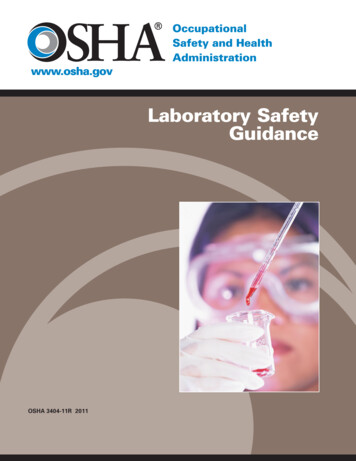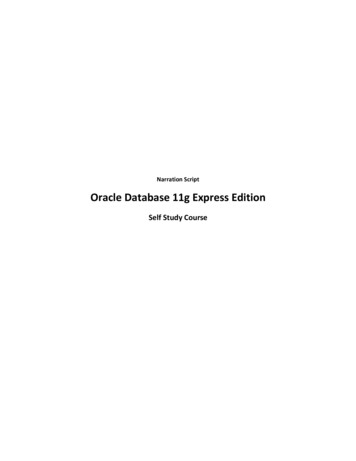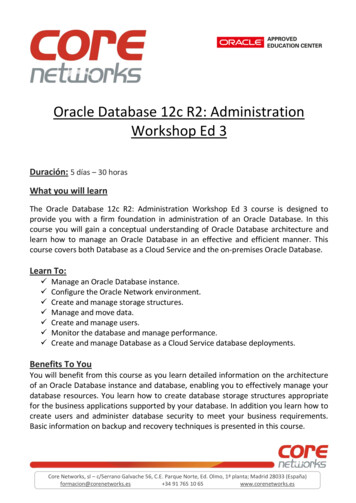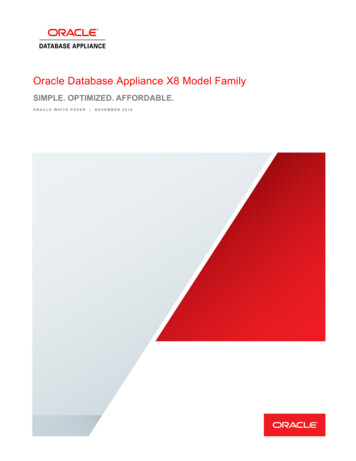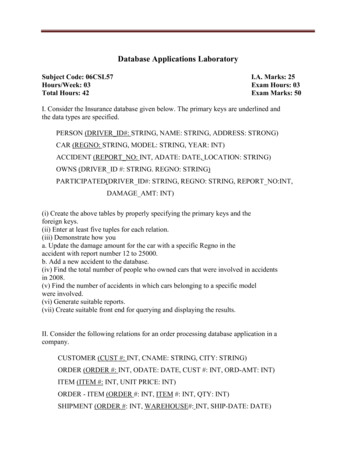
Transcription
Database Applications LaboratorySubject Code: 06CSL57Hours/Week: 03Total Hours: 42I.A. Marks: 25Exam Hours: 03Exam Marks: 50I. Consider the Insurance database given below. The primary keys are underlined andthe data types are specified.PERSON (DRIVER ID#: STRING, NAME: STRING, ADDRESS: STRONG)CAR (REGNO: STRING, MODEL: STRING, YEAR: INT)ACCIDENT (REPORT NO: INT, ADATE: DATE, LOCATION: STRING)OWNS (DRIVER ID #: STRING. REGNO: STRING)PARTICIPATED(DRIVER ID#: STRING, REGNO: STRING, REPORT NO:INT,DAMAGE AMT: INT)(i) Create the above tables by properly specifying the primary keys and theforeign keys.(ii) Enter at least five tuples for each relation.(iii) Demonstrate how youa. Update the damage amount for the car with a specific Regno in theaccident with report number 12 to 25000.b. Add a new accident to the database.(iv) Find the total number of people who owned cars that were involved in accidentsin 2008.(v) Find the number of accidents in which cars belonging to a specific modelwere involved.(vi) Generate suitable reports.(vii) Create suitable front end for querying and displaying the results.II. Consider the following relations for an order processing database application in acompany.CUSTOMER (CUST #: INT, CNAME: STRING, CITY: STRING)ORDER (ORDER #: INT, ODATE: DATE, CUST #: INT, ORD-AMT: INT)ITEM (ITEM #: INT, UNIT PRICE: INT)ORDER - ITEM (ORDER #: INT, ITEM #: INT, QTY: INT)SHIPMENT (ORDER #: INT, WAREHOUSE#: INT, SHIP-DATE: DATE)
Department of Information Science and EngineeringWAREHOUSE (WAREHOUSE #: INT, CITY: STRING)(i) Create the above tables by properly specifying the primary keys and theforeign keys.(ii) Enter at least five tuples for each relation.(iii) Produce a listing: CUSTNAME, #oforders, AVG ORDER AMT, where themiddle column is the total numbers of orders by the customer and the lastcolumn is the average order amount for that customer.(iv) List the order# for orders that were shipped from all the warehouses that thecompany has in a specific city.(v) Demonstrate how you delete item# 10 from the ITEM table and make thatfield null in the ORDER ITEM table.(vi) Generate suitable reports.(vii) Create suitable front end for querying and displaying the results.III. Consider the following database of student enrollment in courses & books adopted for eachcourse.STUDENT (regno: string, name: string, major: string, bdate:date)COURSE (course #:int, cname:string, dept:string)ENROLL ( regno:string, course#:int, sem:int, marks:int)BOOK ADOPTION (course# :int, sem:int, book-ISBN:int)TEXT (book-ISBN:int, book-title:string, publisher:string, author:string)(i) Create the above tables by properly specifying the primary keys and theforeign keys.(ii) Enter at least five tuples for each relation.(iii) Demonstrate how you add a new text book to the database and make thisbook be adopted by some department.(iv) Produce a list of text books (include Course #, Book-ISBN, Book-title) in thealphabetical order for courses offered by the ‘CS’ department that use morethan two books.(v) List any department that has all its adopted books published by a specificpublisher.(vi) Generate suitable reports.(vii) Create suitable front end for querying and displaying the results.IV. The following tables are maintained by a book dealer.AUTHOR (author-id:int, name:string, city:string, country:string)PUBLISHER (publisher-id:int, name:string, city:string, country:string)CATALOG (book-id:int, title:string, author-id:int, publisher-id:int, category-id:int,year:int, price:int)CATEGORY (category-id:int, description:string)ORDER-DETAILS (order-no:int, book-id:int, quantity:int)
Department of Information Science and Engineering(i) Create the above tables by properly specifying the primary keys and theforeign keys.(ii) Enter at least five tuples for each relation.(iii) Give the details of the authors who have 2 or more books in the catalog andthe price of the books is greater than the average price of the books in thecatalog and the year of publication is after 2000.(iv) Find the author of the book which has maximum sales.(v) Demonstrate how you increase the price of books published by a specificpublisher by 10%.(vi) Generate suitable reports.(vii) Create suitable front end for querying and displaying the results.V. Consider the following database for a banking enterpriseBRANCH (BRANCH NAME: STRING, BRANCH-CITY: STRING, ASSETS: REAL)ACCOUNT (ACCNO: INT, BRANCH-NAME: STRING, BALANCE: REAL)DEPOSITOR (CUSTOMER-NAME: STRING, ACCNO: INT)CUSTOMER (CUSTOMER -NAME: STRING, CUSTOMER -STREET: STRING,CITY: STRING)LOAN (LOAN-NO: INT, BRANCH-NAME: STRING, AMOUNT REAL)BORROWER (CUSTOMER-NAME: STRING, LOAN-NO: INT)(i) Create the above tables by properly specifying the primary keys and theforeign keys(ii) Enter at least five tuples for each relation(iii) Find all the customers who have at least two accounts at the Main branch.(iv) Find all the customers who have an account at all the branches located in aspecific city.(v) Demonstrate how you delete all account tuples at every branch located in aspecific city.(vi) Generate suitable reports.(vii) Create suitable front end for querying and displaying the results.Instructions:1. The exercises are to be solved in an RDBMS environment like Oracle or DB2.2. Suitable tuples have to be entered so that queries are executed correctly.3. Front end may be created using either VB or VAJ or any other similar tool.4. The student need not create the front end in the examination. The results of thequeries may be displayed directly.5. Relevant queries other than the ones listed along with the exercises may alsobe asked in the examination.
6. Questions must be asked based on lots.Table of Contents1. Insurance Database2. Order Processing Database3. Student Enrollment Database4. Book Dealer Database5. Bank Enterprise Database6. Creating Front End with Visual Basic7. Viva Questions
Department of Information Science and EngineeringI. Consider the Insurance Database given below. The primary keys are underlined and the datatypes are specified. Write the ER DiagramPERSON (DRIVER ID #: STRING, NAME: STRING, ADDRESS: STRONG)CAR (REGNO: STRING, MODEL: STRING, YEAR: INT)ACCIDENT (REPORT NO: INT, DATE: ADATE, LOCATION: STRING)OWNS (DRIVER ID #: STRING. REGNO: STRING)PARTICIPATED(DRIVER ID#: STRING, REGNO: STRING, REPORT NO:INT,DAMAGE AMT: tion
Department of Information Science and Engineering1) Create the above tables by properly specifying the primary keys and the foreignkeys.CREATE TABLE PERSON(DRIVER ID# VARCHAR2(10),NAME VARCHAR2(20),ADDRESS VARCHAR2(15),PRIMARY KEY(DRIVER ID#));CREATE TABLE CAR(REGNO VARCHAR2(10),MODEL VARCHAR2(10),YEAR NUMBER(4),PRIMARY KEY(REGNO));CREATE TABLE ACCIDENT(REPORT NO NUMBER(5),ADATE DATE,LOCATION VARCHAR2(15),PRIMARY KEY(REPORT NO));CREATE TABLE OWNS(DRIVER ID# VARCHAR2(10),REGNO VARCHAR2(10),PRIMARY KEY(DRIVER ID#,REGNO),FOREIGN KEY(DRIVER ID#) REFERENCES PERSON(DRIVER ID#),FOREIGN KEY(REGNO) REFERENCES CAR(REGNO));CREATE TABLE PARTICIPATED(DRIVER ID# VARCHAR2(10),REGNO VARCHAR2(10),REPORT NO NUMBER(5),DAMAGE AMT NUMBER(7,2),PRIMARY KEY(DRIVER ID#,REGNO,REPORT NO),FOREIGN KEY(DRIVER ID#,REGNO) REFERENCES OWNS(DRIVER ID#,REGNO) ONDELETE CASCADE,FOREIGN KEY(REPORT NO) REFERENCES ACCIDENT(REPORT NO) ONDELETE CASCADE);
Department of Information Science and Engineering2) Enter at least five tuples for each relation.INSERT INTO PERSON VALUES('&DRIVER ID#','&NAME','&ADDRESS');INSERT INTO CAR VALUES('®NO','&MODEL',&YEAR);INSERT INTO ACCIDENT VALUES(&REPORT NO,'&ADATE','&LOCATION');INSERT INTO OWNS VALUES('&DRIVER ID#','®NO');INSERT INTO PARTICIPATED VALUES('&DRIVER ID#','®NO','&REPORT NO',&DAMAGE AMT);3) View the recordsPERSONDRIVER -DX19992002KA01P4020INDICA-VX2002
Department of Information Science and EngineeringACCIDENTREPORT 9911-JUN-0016-OCT-01LOCATIONM G ROADDOUBLEROADM G ROADRESIDENCY ROADRICHMOND ROADOWNSDRIVER 34444KA03L9999KA01P4020PARTICIPATEDDRIVER KA03L9999KA01P4020KA05P1000KA03L9999REPORT NO12200300250002650011DAMAGE AMT2000050010000237570000100004) Demonstrate how you update damage amount for the car with a specific regno inaccident with reportno 12 to 25000UPDATE PARTICIPATEDSET DAMAGE AMT 25000WHERE REPORT NO 12 AND REGNO 'KA04Q2301';
Department of Information Science and EngineeringOutputPARTICIPATEDDRIVER ID# REGNOREPORT NO DAMAGE AMT---------- ---------- ---------- L99991210000Add a new accident to the databaseInsert into accident values (11,’05-MAY-2002’,’RAJAJINAGAR’);Output Select * from accident;ACCIDENTREPORT CT-0105-MAY-02LOCATION--------------M G ROADDOUBLEROADM G ROADRESIDENCY ROADRICHMOND ROADRAJAJINAGAR5) Find the total no of people who owned cars that were involved in accidents 2002.SELECT COUNT(O.DRIVER ID#) FROM OWNS O,ACCIDENT A,PARTICIPATED PWHERE A.REPORT NO P.REPORT NO AND O.DRIVER ID# P.DRIVER ID# AND A.ADATELIKE ’ - -2002’;OutputCOUNT (O.DRIVER ID#)--------------------------------36) Find the number of accidents in which cars belonging to a specific model were involved.SELECT COUNT(*),MODELFROM ACCIDENT A, PARTICIPATED P, CAR CWHERE A.REPORT NO P.REPORT NODON BOSCO INSTITUTE OF TECHNOLOGY, Bangalore-74
Department of Information Science and EngineeringANDP.REGNO C.REGNOANDC.MODEL 'MARUTHI-DX';OutputCOUNT (*)--------------1MODEL------------MARUTHI-DX
Department of Information Science and EngineeringII. Consider the following relations for an Order Processing Database application in acompany. The primary keys are underlined and the data types are specified. Write the ERDiagramCUSTOMER (CUST #: INT, CNAME: STRING, CITY: STRING)ORDER (ORDER #: INT, ODATE: DATE, CUST #: INT, ORD-AMT: INT)ITEM (ITEM #: INT, UNIT PRICE: INT)ORDER - ITEM (ORDER #: INT, ITEM #: INT, QTY: INT)SHIPMENT (ORDER #: INT, WAREHOUSE#: INT, SHIP-DATE: DATE)WAREHOUSE (WAREHOUSE #: INT, CITY: arehouseOdateOrderNoCityOrderCustNoOrderamt1) Create the above tables by properly specifying the primary keys andThe foreign keysWarehouseNo
Department of Information Science and EngineeringCREATE TABLE CUSTOMER(CUST# NUMBER(5),CNAME VARCHAR2(15) NOT NULL,CITY VARCHAR2(15),PRIMARY KEY(CUST#));CREATE TABLE CUSTORDER(ORDER# NUMBER(5) CONSTRAINT PK1 PRIMARY KEY,ODATE DATE,CUST# NUMBER(5) REFERENCES CUSTOMER(CUST#),ORD AMT NUMBER(5));CREATE TABLE ITEM(ITEM NUMBER(5) CONSTRAINT PK2 PRIMARY KEY,UNITPRICE NUMBER(9,2) NOT NULL);CREATE TABLE ORDER ITEM(ORDER# NUMBER (5),ITEM NUMBER (5),QTY NUMBER(4),FOREIGN KEY(ORDER#) REFERENCES CUSTORDER(ORDER#),FOREIGN KEY(ITEM) REFERENCES ITEM(ITEM),PRIMARY KEY(ORDER#,ITEM));CREATE TABLE WAREHOUSE(WAREHOUSE# NUMBER(5),CITY VARCHAR2(15),PRIMARY KEY(WAREHOUSE#));CREATE TABLE SHIPMENT(ORDER# NUMBER(5),WAREHOUSE# NUMBER(5),SHIP DATE DATE,FOREIGN KEY(ORDER#) REFERENCES CUSTORDER(ORDER#),FOREIGN KEY(WAREHOUSE#) REFERENCESWAREHOUSE(WAREHOUSE#),
Department of Information Science and EngineeringPRIMARY KEY(ORDER#,WAREHOUSE#));2) Insert the records into the relationsINSERT INTO CUSTOMER VALUES(&CUSTNO,'&CNAME','&CITY');INSERT INTO CUSTORDERVALUES(&ORDER NO,'&ODATE',&CUSTNO,&ORD AMT);INSERT INTO ITEM VALUES(&ITEM NO,&UNITPRICE);INSERT INTO ORDER ITEM VALUES(&ORDER NO,&ITEM NO,&QTY);INSERT INTO WAREHOUSE VALUES(&WAREHOUSE NO,'&CITY');INSERT INTO SHIPMENTVALUES(&ORDER NO,&WAREHOUSE NO,'&SHIPDATE');3) VIEW THE ORD 430-APR-0651000525-MAY-0615000
Department of Information Science and ORDER E#CITY12345BLOREKOLARCHITTORMLOREMYSORE
Department of Information Science and 01-JUN-063) Producing the listing: custname, order#, avg order amt, where themiddle column is the total no of orders made by the customer, and the last column is theaverage order amount for the customerSELECT C.CNAME, COUNT(*),AVG(CO.ORD AMT)FROM CUSTOMER C, ORDER OWHEREC.CUST# O.CUST# GROUP BY 1000050005000.54) List the order# for orders that where shipped from all the warehousethat the company has in specific city.SELECT ORDER#FROM WAREHOUSE W, SHIPMENT SWHERE W.WAREHOUSE# S.WAREHOUSE# AND CITY 'BLORE';
Department of Information Science and EngineeringOREDER#15) Demonstrate how to delete item 10 from the item table and make that field null inthe ORDER-ITEM tableSELECT CONSTRAINT NAME,CONSTRAINT TYPEFROM USER CONSTRAINTSWHERE TABLE NAME 'ORDER ITEM';CONSTRAINT NAMEC-------------------------------------------- SYS C002734PSYS C002735RSYS C002736RALTER TABLE ORDER ITEM DROP CONSTRAINT SYS C002736;ALTER TABLE ORDER ITEM ADD CONSTRAINT FK1 FOREIGN KEY(ITEM#)REFERENCES ITEM(ITEM#) ON DELETE SET NULL;DELETE FROM ITEM WHERE ITEM# 5;SELECT * FROM ITEMITEM#UNITPRICE1234250050001000-5SELECT * FROM ORDER ITEMORDER#ITEM#QTY12114121134522
Department of Information Science and EngineeringIII. Consider the following database of student enrollment in courses & books adopted for eachcourse. The primary keys are underlined and the data types are specified. Write the ER DiagramSTUDENT (REGNO: STRING, NAME: STRING, MAJOR: STRING, BDATE :DATE)COURSE (COURSE #: INT, CNAME: STRING, DEPT: STRING)ENROLL (REGNO: STRING, COURSE#: INT, SEM: INT, MARKS: INT)BOOK - ADOPTION (COURSE#: INT, SEM: INT, BOOK-ISBN: INT)TEXT (BOOK-ISBN: INT, BOOK-TITLE: STRING, PUBLISHER:STRING, NAuthor
Department of Information Science and Engineering1) Create the above tables by properly specifying the primary keys and the foreignkeysCREATE TABLE STUDENT(REGNO VARCHAR2(10),NAME VARCHAR2(14),MAJOR VARCHAR2(10),BDATE DATE,PRIMARY KEY(REGNO));CREATE TABLE COURSE(COURSE# NUMBER(4),CNAME VARCHAR2(14),DEPT VARCHAR2(10),PRIMARY KEY(COURSE#));CREATE TABLE ENROLL(REGNO VARCHAR2(10),COURSE# NUMBER(4),SEM NUMBER(4),MARKS NUMBER(3),PRIMARY KEY(REGNO,COURSE#,SEM),FOREIGN KEY(REGNO) REFERENCES STUDENT(REGNO),FOREIGN KEY(COURSE#) REFERENCES COURSE(COURSE#));CREATE TABLE TEXT(ISBN NUMBER(5),BOOK TITLE VARCHAR2(13) NOT NULL,PUBLISHER VARCHAR2(12),AUTHOR VARCHAR2(12),PRIMARY KEY(ISBN));CREATE TABLE BOOK ADOPTION(COURSE# NUMBER(5),SEM NUMBER(3),DON BOSCO INSTITUTE OF TECHNOLOGY, Bangalore-74
Department of Information Science and EngineeringISBN NUMBER(4),PRIMARY KEY(COURSE#,SEM),FOREIGN KEY(COURSE#) REFERENCES COURSE(COURSE#),FOREIGN KEY(ISBN) REFERENCES TEXT(ISBN));2)INSERTION OF RECORDS INTO THE RELATIONSØ INSERT INTO STUDENT VALUES('®NO','&NAME','&MAJOR','&BDATE');Ø INSERT INTO COURSE VALUES(&COURSE#,'&CNAME','&DEPT');Ø INSERT INTO ENROLL VALUES('®NO',&COURSE#,&SEM,&MARKS);Ø INSERT INTO TEXT VALUES(&ISBN,'&BOOK TITLE','&PUBLISHER','&AUTHOR');Ø INSERT INTO BOOK ADOPTION VALUES(&COURSE#,&SEM,&ISBN);VIEW THE RECORDS OF THE ECS4CSECS5CIVCIVIL
Department of Information Science and 4223445TEXTBOOK ISBNBOOK LLMAN111005SEPRESSPRESSMANBOOK ADOPTIONCOURSE#1234563SEM1241545BOOK ISBN1110011110041110031110051110061110031110013) DEMONSTRATE HOW YOU ADD NEW TEXT BOOK TO THE DATABASEAND MAKE THAT BOOK IS ADOPTED BY SOME DEPARTMENT.INSERT INTO TEXT VALUES(111006,'AMP','MHP,'BERY);
Department of Information Science and EngineeringINSERT INTO BOOK ADOPTION VALUES(5,5,111006);4) PRODUCE A LIST OF TEXTBOOKS(INCLUDECOURSE,BOOK ISBN,BOOK TITLE) IN THE ALPHABETIC ORDER FORCOURSES OFFERED BY THE ‘CSE’ DEPT THAT USE MORE THAN TWOBOOKS.SELECT C.COURSE#, B.ISBN,BOOK TITLEFROM COURSE C,BOOK ADOPTION B,TEXT TWHERE C.COURSE# B.COURSE# AND B.ISBN T.ISBN ANDC.COURSE# IN (SELECT C1.COURSE# FROM COURSEC1,BOOK ADOPTION B1WHEREC1.COURSE# B1.COURSE# AND DEPT 'CSE'GROUP BY C1.COURSE# HAVING COUNT(*) 2)ORDER BY CNAME;OUTPUTBOOK TITLECOURSE#BOOK MP5) LIST ANY DEPARTMENT THAT HAS ALL ITS ADOPTED BOOKSPUBLISHED BY A SPECIFIC PUBLISHERSELECT DISTINCT C.DEPTFROM COURSE C, BOOK ADOPT B, TEXT TWHERE T.BOOK ISBN B.BOOK ISBNAND B.COURSE# C.COURSE#AND T.PUBLISHER ’TATA’;OUTPUTDEPTCS
Department of Information Science and EngineeringIV. The following tables are maintained by a book dealer. The primary keys are underlined andthe data types are specified. Write the ER DiagramAUTHOR (AUTHOR-ID: INT, NAME: STRING, CITY: STRING, COUNTRY: STRING)PUBLISHER (PUBLISHER-ID: INT, NAME: STRING, CITY: STRING, COUNTRY:STRING)CATALOG (BOOK-ID: INT, TITLE: STRING, AUTHOR-ID: INT, PUBLISHER-ID: INT,CATEGORY-ID: INT,YEAR: INT, PRICE: INT)CATEGORY (CATEGORY-ID: INT, DESCRIPTION: STRING)ORDER-DETAILS (ORDER-NO: INT, BOOK-ID: INT, QUANTITY: tegoryCategoryidDON BOSCO INSTITUTE OF TECHNOLOGY, Bangalore-74
Department of Information Science and Engineering1) Create the above tables by properly specifying the primary keys andthe foreign keysCREATE TABLE AUTHOR(AUTHORID NUMBER(5),NAME VARCHAR(15),CITY VARCHAR2(15),ACOUNTRY VARCHAR(15),PRIMARY KEY(AUTHORID));CREATE TABLE PUBLISHER(PUBLISHERID NUMBER(5),NAMEVARCHAR(15),CITY VARCHAR2(15),COUNTRY VARCHAR(15),PRIMARY KEY(PUBLISHERID));CREATE TABLE CATEGORY(CATEGORYID NUMBER(5),DESCRIPTION VARCHAR(15),PRIMARY KEY(CATEGORYID));CREATE TABLE CATALOG(BOOKID NUMBER(5),TITLE VARCHAR2(15),AUTHORID NUMBER(5),PUBLISHERID NUMBER(5),CATEGORYID NUMBER(5),YEAR NUMBER(5),PRICE NUMBER(10,3),PRIMARY KEY(BOOKID),FOREIGN KEY(AUTHORID) REFERENCES AUTHOR(AUTHORID),FOREIGN KEY(PUBLISHERID) REFERENCES PUBLISHER(PUBLISHERID),FOREIGN KEY(CATEGORYID) REFERENCES CATEGORY(CATEGORYID));CREATE TABLE ORDER DETAILS(ORDERNO NUMBER(5),BOOKID NUMBER(5),QUANTITY NUMBER(5),PRIMARY KEY(ORDERNO,BOOKID),FOREIGN KEY(BOOKID) REFERENCES CATALOG(BOOKID)DON BOSCO INSTITUTE OF TECHNOLOGY, Bangalore-74
Department of Information Science and Engineering);2) INSERT THE RECORDS INTO THE RELATIONSINSERT INTO );INSERT INTO NTRY');INSERT INTO CATEGORY VALUES(&CATEGORYID,'&DESCRIPTION');INSERT INTO CATALOG TEGORYID,&YEAR,&PRICE);INSERT INTO ORDER DETAILS VALUES(&ORDERNO,&BOOKID,&QUANTITY);3) VIEW THE RELATIONSAUTHORAUTHORID ------------ --------------- --------------- RYID DESCRIPTIONM-------------------- medbiometeormechINDIAenglandINDIAsrilankaindia
Department of Information Science and EngineeringCATALOGBOOKIDTITLE AUTHORID PUBLISHERID CATEGORYID YEAR PRICE--------- --------------- ---------- ----------- ---------- 1000419981997200120022003235255352523124ORDER 100000215310000032341000003145100000574) GIVE THE DETAILS OF THE AUTHORS WHO HAVE TWO OR MORE BOOKS INTHE CATALOG AND THE PRICE OF THE BOOKS IS GREATER THAN THEAVERAGE PRICE OF THE BOOKS IN THE CATALOG & THE YEAR OFPUBLICATION IS AFTER 2000.SELECT * FROM AUTHOR A WHERE A.AUTHORID IN(SELECT C.AUTHORID FROM CATALOG CWHERE YEAR 2000 ANDC.PRICE (SELECT AVG (PRICE) FROM CATALOG)GROUP BY C.AUTHORID HAVING COUNT (AUTHOR-ID) ) FIND THE AUTHOR OF THE BOOK WHICH HAS MAXIMUN SALESSELECT NAME FROM AUTHOR WHERE AUTHORID IN(
Department of Information Science and EngineeringSELECT AUTHORID FROM CATALOG , ORDER DETAILS O WHERE O.BOOKID CATALOG.BOOK-ID AND QUANTITY 9SELECT MAX(QUANTITY) FROM OREDERDETAILS));NAME--------DEF6) DEMONSTRATE HOW YOU INCREASE THE PRICE OF BOOK PUBLISHED BY ASPECIFIC PUBLISHER BY 10%.UPDATE CATALOG SET PRICE PRICE PRICE*0.10WHERE PUBLISHERID IN (SELECT P.PUBLISHERIDFROM PUBLISHER PWHERE P.NAME '’PBP’);OutputSQL SELECT * FROM 00041000005TITLE AUTHORID PUBLISHERID CATEGORYID YEAR----------- --------------- ------------------- --------------------- 03PRICE-------258255352523124
Department of Information Science and EngineeringV. Consider the following database for a banking enterprise. The primary keys are underlinedand the data types are specified. Write the ER DiagramBRANCH (BRANCH NAME: STRING, BRANCH-CITY: STRING, ASSETS: REAL)ACCOUNT (ACCNO: INT, BRANCH-NAME: STRING, BALANCE: REAL)DEPOSITOR (CUSTOMER-NAME: STRING, ACCNO: INT)CUSTOMER (CUSTOMER -NAME: STRING, CUSTOMER -STREET: STRING,CITY: STRING)LOAN (LOAN-NO: INT, BRANCH-NAME: STRING, AMOUNT REAL)BORROWER (CUSTOMER-NAME: STRING, LOAN-NO: INT)AccNoBcitybalancAccountBranchAccountCnameB CustomerBorrowLoan
Department of Information Science and Engineering1) CREATION OF TABLES WITH NECESSARY CONSTRAINTSCREATE TABLE BRANCH(BRANCH NAME VARCHAR2(15),BRANCH CITY VARCHAR2(15),ASSETS NUMBER(10,3),PRIMARY KEY(BRANCH NAME),CHECK(ASSETS 0));CREATE TABLE CUSTOMER(CUSTOMER NAME VARCHAR2(15),CUSTOMER ADDRESS VARCHAR2(15),CUSTOMER CITY VARCHAR2(15),PRIMARY KEY(CUSTOMER NAME));CREATE TABLE ACCOUNT(ACCNO VARCHAR2(15),BRANCH NAME VARCHAR2(15),BALANCE NUMBER(11,4),PRIMARY KEY(ACCNO),FOREIGN KEY(BRANCH NAME) REFERENCESBRANCH(BRANCH NAME) ON DELETE CASCADE);CREATE TABLE DEPOSITOR(CUSTOMER NAME VARCHAR2(15),ACCNO VARCHAR2(15),PRIMARY KEY(CUSTOMER NAME,ACCNO),FOREIGN KEY(CUSTOMER NAME) REFERENCESCUSTOMER(CUSTOMER NAME)ON DELETE CASCADE,FOREIGN KEY(ACCNO) REFERENCESACCOUNT(ACCNO) ON DELETE CASCADE);CREATE TABLE LOAN
Department of Information Science and Engineering(LOAN-NO NUMBER(6),BRANCH NAME VARCHAR2(15),AMOUNT NUMBER(10,4),PRIMARY KEY(LOAN-NO),FOREIGN KEY(BRANCH NAME) REFERENCESBRANCH(BRANCH NAME)ON DELETE CASCADE);CREATE TABLE BORROWER(CUSTOMER NAME VARCHAR2(15),LOAN-NO NUMBER(5),PRIMARY KEY(CUSTOMER NAME,LOAN-NO),FOREIGN KEY(CUSTOMER NAME) REFERENCESCUSTOMER(CUSTOMER NAME)ON DELETE CASCADE,FOREIGN KEY(LOAN-NO) REFERENCESLOAN(LOAN-NO)ON DELETE CASCADE);2)INSERTION OF TUPLES INTO THE RELATIONØ INSERT INTO BRANCH VALUES('&BRANCH NAME','&BRANCH CITY',&ASSETS);Ø INSERT INTO CUSTOMER VALUES('&CUSTOMER NAME','&CUSTOMER ADDRESS','&CUSTOMER CITY');Ø INSERT INTO ACCOUNT VALUES('&ACCNO','&BRANCH NAME',&BALANCE);Ø INSERT INTO DEPOSITOR VALUES('&CUSTOMER NAME','&ACCNO');Ø INSERT INTO LOAN VALUES(&LOAN-NO,'&BRANCH NAME',&AMOUNT);Ø INSERT INTO BORROWER VALUES('&CUSTOMER NAME',&LOAN-NO);3)VIEW THE OMERSTREETCUSTOMERCITYAJAYM G ROADBLORE
Department of Information Science and EngineeringSUMUKHBRIGADE ROADBLORESANTAMOUNT ROADCHENNAIAMITRAJNATHDELHIRAJATHA S LOANNO
Department of Information Science and RAJATH504) FIND ALL CUSTOMERS WHO HAVE ACCOUNT AT ALLTHE BRANCHES LOCATED IN A SPECIFIC CITY SELECT D.CUSTOMERNAMEFROM DEPOSITOR D, ACCOUNT A, BRANCH BWHERE D.ACCNO A.ACCNO ANDA.BRANCHNAME B.BRANCHNAME ANDB.BRANCHCITY ’CHENNAI’GROUP BY D.CUSTOMERNAMEHAVING COUNT(A.BRANCHNAME) (SELECT COUNT(X.BRANCHNAME)FROM BRANCH XWHERE X.BRANCHCITY ------AJAYAMITRAJANTSANTASUMUKH5) FIND ALL CUSTOMERS WHO HAVE AT LEAST TWO ACCOUNTSAT THE MAIN BRANCH SELECT D.CUSTOMERNAMEFROM DEPOSITOR D, ACCOUNT A, BRANCH BWHERE D.ACCNO A.ACCNO ANDA.BRANCHNAME B.BRANCHNAME ANDB.BRANCHCITY ’CHENNAI’GROUPBY C.CUSTOMERNAMEHAVING COUNT (*) 2;OutputCUSTOMERNAME-------------------------
Department of Information Science and EngineeringAJAY6) DEMONSTRATE HOW YOU DELETE ALL THE TUPLES AT EVERY BRANCH LOCATEDIN A PARTICULAR CITYDELETE FROM ACCOUNTWHERE BRANCHNAME IN ( SELECT B.BRANCHNAMEFROM BRANCH BWHERE B.BRANCHCITY 'BLORE');OutputSQL /3 ROWS DELETEDSQL SELECT * FROM 5ANDHRI6000EXTRA QUERIES1) SUPPOSE THAT ANNUAL INTEREST PAYMENTS ARE BEING MADE AND ALLBRANCHES ARE TO BE INCREASED BY 3%.2) IF INTEREST IS TO BE PAID ONLY TO ACCOUNTS WITH A BALANCE OFRs.1000 OR MORE.3) FIND ALL LOAN NUMBERS FOR LOANS MADE AT KUMBALAGODU BRANCHWITH LOAN AMOUNT ABOVE Rs.5000.4) FIND THE LOAN NUMBER OF THOSE LOANS WITH LOAN AMOUNTS BETWEEN10000 AND 40000.5) FIND ALL THE CUSTORES HAVING A LOAN, AN ACCOUNT OR BOTH AT THEBANK.6) FIND ALL THE CUSTORES WHO HAVE AN ACCOUNT AND A LOAN AT THEBANK.7) FIND THE AVERAGE ACCOUNT BALANCE AT EACH BRANCH.8) FIND THE NUMBER OF DEPOSITORS FOR EACH BRANCH.DON BOSCO INSTITUTE OF TECHNOLOGY, Bangalore-74
Department of Information Science and Engineering9) FIND THE BRANCHES WHERE THE AVERAGE ACCOUNT BALANCE ISMORE THAN Rs.5000.10) FIND THE NAMES OF ALL BRANCHES THAT HAVE AN ASSET VALUEGREATER THAN THAT OF EACH BRANCH IN BANGALORE.11) FIND THE NAMES OF ALL THE BRANCHES OF LOAN RELATIONCreation of suitable Front End using Visual Basicfor querying and displaying the resultsSTEP 1:Create the necessary FORM using label, textbox & button controls.STEP 2:Establish connectivity between User interface screens & Database1. Select components from the project menu2. Select MS ADO Data Control 6.0 ( OLE DB) & click OK
Department of Information Science and Engineering3. Add the ADODC from the ToolBox to the form & name thecontrol adcBranch4. Set ConnectString, CommandType & Record Source properties of the ADOData Control as follows5. Right click on adcBranch data control & select ADODC Properties6. To set the connection [property click on BUILD button & you get aData Link Dialog box as follows
Department of Information Science and Engineering6. Select MS OLE DB Provider for Oracle & Click on NEXT button7. Enter User name & Password & Test connection8. Click OK. Click Authentication TAB & enter User Name & password &Click on APPLY button.
Department of Information Science and Engineering9. Click on RecordSource TAB & select 2 - adCmdTable. Wait till the tablesare listed in the Table combo Box
Department of Information Science and Engineering10. Select the BRANCH table & click on APPLY11. Click on OK button to complete the settingsSTEP 3:Binding the FORM Controls to the Table Fields1. Select the txtBranchName control, right click & select properties.2. In the properties windows set DataSource & DataField ( In that order)Select adcBranch in DataSource & BRANCH NAME in DataFieldas shown below.
Department of Information Science and EngineeringSTEP 4: Add Events to BUTTON controls1. Double click on the New button & add the following codePrivate Sub New Click()adcBranch.Recordset.AddNewEnd Sub2. Double click on the Save button & add the following codePrivate Sub Save Click()adcBranch.Recordset.SaveMsgBox "Record Added Successfully"End Sub
Department of Information Science and Engineering3. Double click on the Update button & add the following codePrivate Sub Update et.SaveMsgBox "Record Updated Successfully"End Sub4. Double click on the Delete button & add the following codePrivate Sub Delete et.SaveMsgBox "Record Deleted."adcBranch.Recordset.MoveNextEnd SubSTEP 5: Execute the program1. Select Run menu2. Click on start sub menu
Department of Information Science and EngineeringVIVA QUESTIONS1). what is DBMS?1) What are the advantages of DBMS?2) Differentiate between DBMS and RDBMS.3) Explain the three schema architecture.4) What is data independence?5) Explain different data models.6) Explain ER model.7) What is an entity?8) What is a weak entity?9) What is total dependency?10) Explain the different types of attributes.11) What is Hierarchical model?12) What is Network model?13) What is a derived attribute? Give an example.14) Explain different mapping constraints.15) Define primary key16) Define candidate key17) Define Unique key18) Define super key19) What is Referential Integrity?20) What is
the price of the books is greater than the average price of the books in the catalog and the year of publication is after 2000. (iv) Find the author of the book which has maximum sales. (v) Demonstrate how you increase the price of






